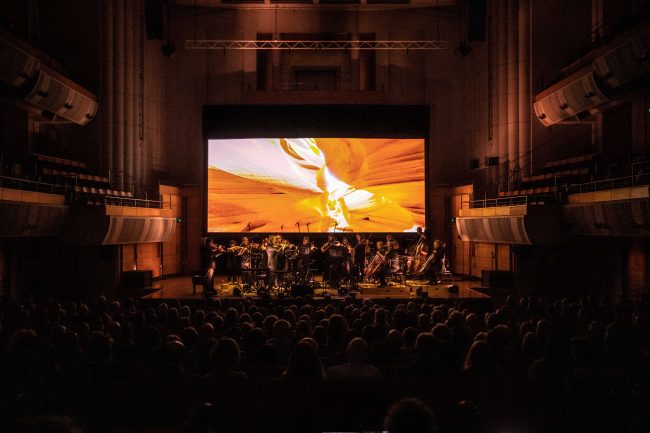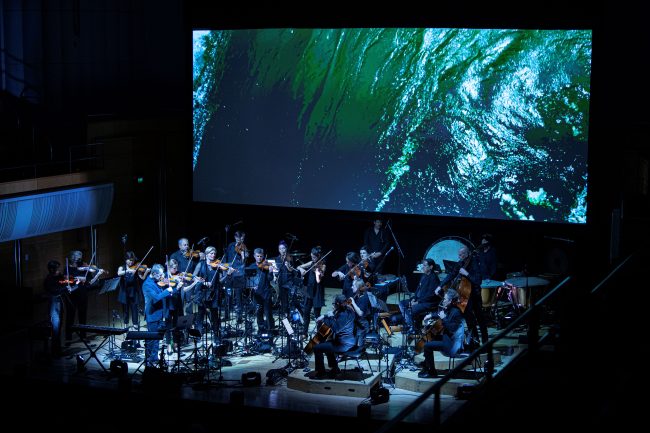Tuesday 13 February 2024
Review by Paul Neeson (Arts Wednesday)

After the success of Mountain in 2017, the Australian Chamber Orchestra immediately embarked on their next cinematic endeavour. After extensive deliberation and collaboration, River Live was ready to go on tour in 2021. We had all been receiving the advance publicity for some time and were collectively disappointed when it was postponed for the usual 2021 reasons. Now 2024 is the year for River Live and all our expectations were met and satisfied in buckets.

From the very beginning we were given a taste of things to come when a quote from W.H. Auden appeared on screen: “Thousands have lived without love, not one without water.” Poignant and serious indeed. One could sense the audience get ready to settle in for the ride…
The opening scene of a lone kayaker taking on the ferocity of an almost vertical gargantuan waterfall, on a cinematic loop taken from different angles, we watched in horror, exhilaration and excitement as he rode the infinite mass of surging water down, down and down again, into an apparent abyss, serving to accentuate the incredibly powerful metaphor: the extent to which mankind will go in order to master nature. Tognetti’s interpretation of the Vivaldi RV 232 concerto that accompanied these images was extraordinary in its passion and persistence, it echoed the unremitting power of the waterfall. We knew we were about to experience and witness through film something exceptional and unique in the world of classical performance.

But it was also a film and required all the conventions that go with the projection of moving images, such as a soundtrack. And that was provided by the ACO with original music cues composed by Tognetti, Piers Burbruck de Vere and William Barton. For the most part the music (including the pieces from the standard classical repertoire) functioned as film music should, highlighting the emotion at times and providing an ambience that sits comfortably behind other elements of the film e.g. narration or sound effects. Only on a few occasions did the balance not seem quite right with Willem Dafoe’s narration disappearing under the music. The story at that point had turned to the troubled relationship that humans have with water and our often too flagrant use of it – toxic chemicals causing algal blooms; rivers dammed, their wildness tamed, we then contemplate the downstream and upstream damage for populations and ecosystems. Perhaps then, by drowning out the narrator’s voice, overwhelming it by the power of the music and visual theatrics, the focus is placed squarely on the natural elements: the human (narrator) presence recedes, pales into insignificance in comparison to the might of nature which prevails albeit waxing and waning into eternity – so it may well have been an artistic choice.

The lack of brass and woodwind instruments in the score were missed at first in this cinematic context (it was the ACO after all), but it didn’t matter because suddenly we became aware that orchestral colour was being added not only by dramatic percussive highlights but also a solo female voice. Principal Violin, Satu Vanska came to sing for us, Water, by Johnny Greenwood from rock group Radiohead. Her trademark poise, grace and understated elegance seamlessly Stransferred from the violin to the microphone with a vocal of such effortless control, faultlessly in tune (in the mould of Jane Sheldon, even Sade), holding long notes but somehow avoiding vibrato to create a pure tone, an earthy full bodied tone that reflected so resolutely all the harmonic changes going on around her. At another point yidaki virtuoso, William Barton, created a very spiritual vocal improvisation that was both simultaneously haunting, ethereal and uplifting. And how fitting was the sound of the didgeridoo as the soundtrack to images of indigenous peoples around the world dealing with water issues (too much or none at all).

The cinematography was truly astounding. Images of river systems taken from a very great height unmistakably resembled the patterns of trees, branches, leaves etc, that spoke to the predictability of natural forces in flora, topography and wildlife. The same forces shape them all with similar visual results. On so many occasions we didn’t know exactly what it was we were seeing: rock formations, river systems, ice, cave or desert; the common denominator was that they had all been shaped by water at some point. Remarkable! Also of note were the transitions from detail to the bigger picture, for example, a single dead fish on a river bank, to then a dozen, then too many to count – as far as the viewer could see.
But with all the creatives involved in this enormous artistic project, credit must go to writer and director, Jennifer Peedom. To bring together breath-taking cinematography, a world class live music soundtrack, editing, script, narration, staging, lighting and mixing was a monumental feat. You just had to look at all the cables on the stage to understand the technical complexity of the performance.
Fortunately for us the closing credits to list them all were so long, it gave us time to enjoy the final music work, the adagio from Mahler’s Symphony No. 4. (or at least an abridged version). We had come a long way on our fluvial journey. It was time to breathe out again and head out into the balmy Sydney evening.
Listen to a recent interview with ACO Principal Violin, Satu Vanska below:
Share "Review: River Live at the City Recital Hall, Angel Place"
Copy










